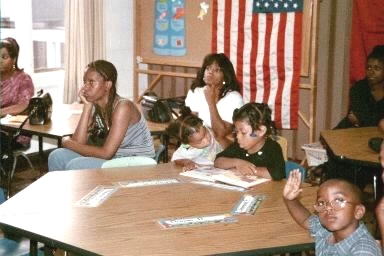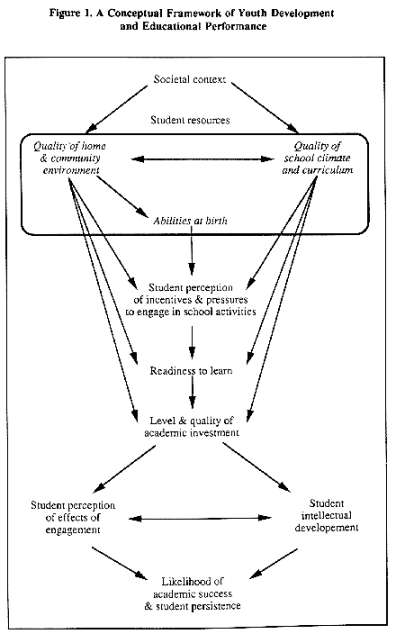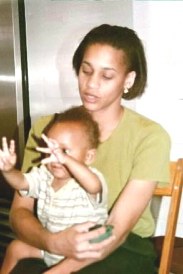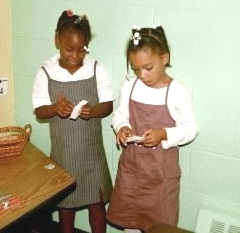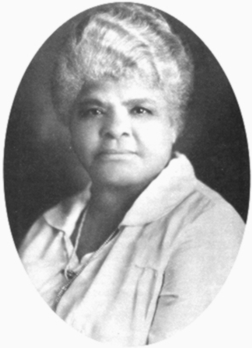
Ida B. Wells-Barnett The Ida B. Wells Community Academy Hosted by the Antioch Baptist
Church of Akron COUNTY:
Summit
IRN: 133553 Part II: Annual Report for 1999-2000
Demographic Description of Student Body The Academy’s student body is 100% African American; all are residents of Akron, Ohio; and most reside on the East and West sides of the city. Akron’s public school student population, according to 1997-1998 statistics, is approximately 32,331; of this number approximately 16,650 (51.5%) are white; 15,137 (46.8%) are African American [4]. As stated in our contract with the ODE, the Academy posited an attempt to achieve racial balance in its student body which indicated a number of strategies we would employ. The results, given the nature of the community the Academy operates in, were very negligible. The Academy anticipated this outcome; however, it continued to persevere in its good faith attempts to attract students who were not African American by posting posters and fliers in community agencies outside the communities from which our students primarily came: community centers, business establishments, newspapers that serve a primarily Caucasian readership, major media such as the Akron Beacon Journal, radio/TV networks, etc. Another such strategy employed was the “Interdistrict Transfer Option” (see Attachment VIII). The Academy learned of this possibility too late to pursue it with the vigor it required. A more vigorous attempt will be engaged in the 2000-2001 academic year. The Academy’s student body is perhaps best described in terms of its SES (Social Economic Status): they were primarily low income (see Attachments I) which includes other demographic data as well.
Assessment Rationale The Academy has from its inception (and indeed before) held a jaundiced view of the nation’s and subsequently the Ohio State Department of Education’s emphases on paper and pencil proficiency tests. We believe there must exist other and perhaps better methodologies for assessing student proficiency or competence, or for assessing the Academy’s accountability. We suggest using various other value added cognitive probes. For intellectual development, especially for poor and African American students, should be based on a host of cultural, affective or socio-emotional variables that do not necessarily impact Caucasian learners similarly. Rosalie Cohen (1969), [5] Asa Hilliard, Fuller Calloway Professor of Education, Georgia State University (1976) [6] and a number of other educational scholars [7] have stressed these variables over the years, but in the main they have been given very short shrift when it comes to developing methods for assessing the intellectual development of these people. We find it pedagogically distracting for the Academy to devote an abundance of time and attention to an admittedly important area which forces us to decrease the gross amount of time devoted to other also admittedly important areas of assessment which may be eminently more effective. Educational literature is becoming replete with refusals of students and their instructors to submit themselves to a proficiency test regime. We are not suggesting that the Academy’s students or their parents do the same. But something must certainly be done. Recently, the Milwaukee Public Schools introduced an all-out proficiency testing program which has several flaws and has incited parents and teachers to protest the counterproductive and undemocratic manner used to introduce the testing program [8]. The following was reported about the protest and about proficiency testing at the expense of equally valuable learning and assessment strategies. First, MPS is pushing the proposal with undue haste and a lack of democratic input. "This proposal touches the heart of the educational process," Mary Diez, graduate dean at Milwaukee's Alverno College and a national expert on assessment, wrote in a letter to the MPS School Board. "Shouldn't parents, teachers, and others in the public who are concerned with the quality of public education be able to help shape the plan?" 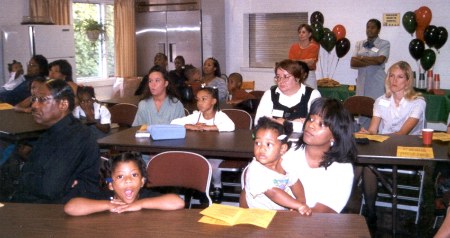 Attentive Parents, Teachers and Children at the Academy Open House All students in America’s educational system are at Risk [9] whether they are white or African American, or Native American, or Latino, or Asian, well off or poor. Because of the nation’s long lived racial problems and refusal to address the years of economic, political and psychological damage done to an entire race or class of people, African Americans in the system are hit with a double whammy. In January 1994, Robert Rossi and Alesia Montgomery of American Institutes for Research, edited and published Education Reforms and Students at Risk: A Review of the Current State of the Art. [10] In this lengthy report, they presented "An Alternative Model of Student Performance" in their Chapter 5, This is an interactive model of those forces which poor students in general and African American students and their families in particular have to contend with. Figure 1 makes an adequate, if not exact diagram of how these forces tend to interact.
This figure demonstrates how student performance is primarily a result of (1) the quality of the student’s abilities, family support and educational opportunities and (2) the ways in which a student perceives the personal advantage in investing his/her resources in educational achievement. The student’s awareness of how relatives, siblings and significant others in their neighborhood have made educational investments and have received visible "returns" plays a major role in this equation. This knowledge then favorably impacts the student's ability and desire to achieve success and to remain in school hopefully until graduation.
The figure also notes that
the perception of the effects of intellectual
engagement may change and having done so may dramatically alter future
academic investment and development. In order to provide students with
a quality education, schools, for example the Academy, must foster
intellectual
curiosity, increase expectations of success, encourage student, parent
and community interest and active involvement (i.e., investment) in the
classroom and school related "Resources," as we interpret the model, includes for example good health and high quality instruction. These variables, according to the authors can increase the student’s chances of possessing the ability, willingness, or opportunities for enhanced engagement and academic and psychological development. The absence of basic resources (e.g., adequate nutrition and comfortable shelter) may place a child at risk, while the presence of special resources (e.g., private tutoring in advanced subjects, good library of children’s reading materials in the home, and regular discussions about domestic and world events) may give a child an advantage in relation to his or her peers As resources improve and eliminate the risk factors that threaten academic progress, student should no longer be considered or labeled “at risk.” The Academy has offered the foregoing discussion and the “Youth Development and Educational Performance Model” in a effort to underscore why the Academy does not categorically accept the prevailing national emphasis on standardized proficiency tests. In our view educational reform, assessment and accountability strategies must not be based entirely on how students fare on standardized proficiency tests. These tests are only one method for evaluating intellectual value added. The Academy therefore attempted during its premier academic year to devise, perfect and utilize a variety of assessment methodologies in combination with standardized testing instruments always keeping the cultural [11] dimension foremost in its collective mind. Assessment Tools and Scores Since the Academy enrolls only students in Kindergarten through 2nd Grade, it has not had to administer state mandated proficiency tests; it has, however, remained mindful of its end goal, namely that of having the Academy’s students undergo an educational process designed over the next two years to have at least our third graders prepared to take and succeed on the 4th and 6th Grade proficiency tests. The staff is determined, nonetheless, not to fall into the counterproductive process of teaching the test. Proficiency in many areas like intelligence and competence in general cannot necessarily be determined by scores on paper tests alone. This does not mean the Academy will not, when they are appropriate and/or necessary (i.e. mandated), administer standardized proficiency tests as required by the state. What it does mean, however, is that the Academy’s faculty and staff have, and will continue to put their minds and creative energies to the development of additional measurable means, activities and methodologies to effect a more informative overall assessment of their students’ progress. The above description of our developing educational philosophy suggests the Academy is moving toward being educationally accountable to Ohio’s proficiency and competency-based program, to our students and their parents, and to the Akron community at large. In fact in our chartering contract with ODE, the Academy described (see “Exhibit I: Educational Plan,” pp. 15-16) how it would conduct in part its assessment strategies. To arrive at a measurable point of pedagogical clarity, if not certainty, the faculty have also determined to choose from the following Academy selected assessment tools and more:
The Academy, as stated
earlier on, has strengthened its assessment or accountability
posture by adding to its regimen a battery of standardized assessment
tools.
They are . . .
In the main these test
scores show our students to be overly in need of
academically support. The faculty initiated their own individual
assessment
analyses (see Attachment IV). It must not be overlooked that the
Academy
is currently working with children ages 5 to 7 – kindergarten through
the
second grade. It must also be recognized that the Academy is, save for
those five-year olds, dealing with some serious, and stubborn
educational
problems on the one hand and students who have had poor educational
experiences
in the Akron’ public schools on the other. We knew we would
eventually face the problem of having our second
graders entering
the third grade. These youngsters will need to be well prepared, for
they
must be able to prepare for the fourth grade proficiency exam.
Funding Sources State Funds OHIO DEPARTMENT OF
EDUCATION COMMUNITY SCHOOL: Ida B. Wells Community Academy COUNTY:
Summit
IRN: 133553
This was a very skimpy funding picture, for most of the monies the academy received were expended on instructional and administrative salaries, facility leases, office and classroom equipment purchases and rentals, student transportation costs for 210 days including field trips, office and educational supplies, conferences and workshops attendance, etc. The LOEO reports stressed one of the biggest problems community schools face is finding and keeping an adequate facility. Indeed, the startup workshops we attended also stressed the need to find a suitable facility. Since that is known to state funding sources, why do community schools not share in the capital expenses, i.e., school building, and transportation funds, that the school district gets for each child in attendance. Why don't we receive an outright allocation similar to the method used to fund DPIA and foundation funds and others that we do not yet know of?
END NOTES 4. See "A Curriculum Management Audit of Akron Public Schools, Ohio." The audit was conducted by the Internal Curriculum Management Audit Center, Phi Delta Kappa, August 1998, p. 3. 5. “Conceptual Styles, Culture Conflict and Nonverbal Tests of Intelligence.” American Anthropologist, 71:828-56. 6. “Alternatives to IQ Testing: An Approach to the Identification of Gifted Minority Children.” Final Report to the California State Department of Education. 7. See Janice E. Hale-Benson. (1982). Black Children, Their Roots, Culture, and Learning Styles. (Baltimore: The Johns Hopkins University Press. 8. From Rethinking Schools Online: An Urban Educational Journal, Summer 2000. This journal is available at http://www.rethinkingschools.org. 9. See “An Open Letter to the American People: A Nation At Risk: The Imperative For Educational Reform” (April 1983). Go to http://www.ed.gov/pubs/NatAtRisk/risk.html to read the full document. See also “A Nation Still At Risk An Education Manifesto” (April 30, 1998). Go to http://edreform.com/pubs/manifest.htm to read this manifesto. 10. Go to http://www.ed.gov/pubs/EdReformStudies/EdReforms/chap5c.htm to read the the entire chapter. 11.
“Cultural,” as we use it here, refers not only to race and ethnicity
but
also to the cultural anthropological fact that children born and reared
in the last years of the twentieth century, do not necessarily share
the
same cultural attitudes, values or life and learning styles as those
who
were born 20, 30 or more years before them. These examiners share a
culture
at variance with their’s. A serious problem arises, it seems, when
these
individuals are then assigned to construct “achievement” tests that can
impact a student’s self concept and, indeed, the quality of her or his
life. See Reginald L. Jones, ed. (1996). Handbook of Tests and
Measurements
for Black Populations. 2 Vols. Hampton, VA: Cobb & Henry
Publishers,
for a comprehensive discussion of culture specific test and measurement
instruments. NB: The
Attachments referred to in this report may be requested from the
Webmaster via an e-mail indicating which
attachment
is wanted. End of Part II |
Navigational Links
 Back
to Top of this Page
Back
to Top of this Page |
 Return
to Part I: Annual Report
Return
to Part I: Annual Report |
 Return to Home
Page
Return to Home
Page |
 Forward
to Part III: Annual Report
Forward
to Part III: Annual Report |
|
|
For More Information Write or Call
Dr. Edward W. Crosby, PhD, Co-Founder, Superintendent
or
Mr. Perkins B. Pringle, MEd, Principal
or
Ms. Angela M. Anderson, MBA, Business Manager / Board Treasurer
The Ida B. Wells Community Academy
670 Wooster Avenue
Akron, Ohio 44307-1868
Voice: 330.376.4915 – FAX: 330.376.4912
Contact the Webmaster
to give feedback
Click on the World and Sign
the HieroGraphics Online Guestbook
We Are a Quality and Equal Education and Employment
Opportunity Institution
